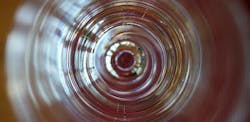IMAGE: This image accompanies a news release from the University of Cambridge that describes a new class of spongy metal-organic 'hybrid glasses'. (Image credit: Rosmarie Voegtli/Flickr)
An international team of researchers reports in the journal Nature Communications how they have managed to use a relatively new family of sponge-like porous materials to develop new hybrid glasses. These engineered glasses could satisfy applications in advanced photonics, while also facilitating industrial-scale carbon capture and storage.
RELATED ARTICLE: Porous-silicon optical filter withstands wide temperature swings
The new glasses revolve around a family of compounds called metal-organic frameworks (MOFs), which are cage-like structures consisting of metal ions, linked by organic bonds. Their porous properties have led to proposed application in carbon capture, hydrogen storage and toxic gas separations, due to their ability to selectively adsorb and store pre-selected target molecules, much like a building a sieve which discriminates not only on size, but also chemical identity.
However, since their discovery a quarter of a century ago, their potential for large-scale industrial use has been limited due to difficulties in producing linings, thin films, fibrous or other 'shaped' structures from the powders produced by chemical synthesis. Such limitations arise from the relatively poor thermal and mechanical properties of MOFs compared to materials such as ceramics or metals, and have in the past resulted in structural collapse during post-processing techniques such as sintering or melt-casting.
Now, a team of researchers from Europe, China, and Japan has discovered that careful MOF selection and heating under argon appears to raise their decomposition temperature just enough to allow melting, rather than the powders breaking down. The liquids formed have the potential to be shaped, cast and recrystallized, to enable solid structures with uses in gas separation and storage.
Equally importantly, say the researchers, is that the glasses that can be produced by cooling the liquids quickly are themselves a new category of materials. Further tailoring of the chemical functionalities may be possible by incorporating different elements into MOFs before melting and cooling.
Yuanzheng Yue from Aalborg University adds, "A second facet to the work is in the glasses themselves, which appear distinct from existing categories. The formation of glasses that contain highly interchangeable metal and organic components, in is highly unusual, as they are normally either purely organic, for example in solar cell conducting polymers, or entirely inorganic, such as oxide or metallic glasses. Understanding the mechanism of hybrid glass formation will also greatly contribute to our knowledge of glass formers in general."
Using the advanced capabilities at the UK's synchrotron, Diamond Light Source, the team was able to scrutinize the metal organic frameworks in atomic detail. The researchers believe the new technique could open up the possibility of the production of 'chemically designed' glasses whereby different metals or organics are swapped into, or out of, the MOFs before melting.
SOURCE: University of Cambridge; http://www.cam.ac.uk/research/news/new-glass-manufacturing-technique-could-enable-design-of-hybrid-glasses-and-revolutionise-gas
